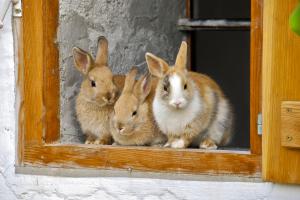Naturally sociable, rabbits love the company of their fellow rabbits. In fact, companionship is so important for their well-being that you'll typically only find them in groups or pairs. This is the story for wild rabbits too, who thrive among their own kind.
But can rabbits live alone and, if not, how do you go about introducing a single rabbit to a friend?
Help, my rabbit lives alone!
Don't despair. In some circumstances, rabbits can live alone, providing their need for companionship is met. This means investing quality time on a daily basis to ensuring their care. Grooming, playing and handling are all important aspects when it comes to creating a solid bond between human and rabbit, and the importance of this when caring for a solo rabbit should never be underestimated.
That said, companionship between two or more rabbits is usually preferable as we all lead busy lives, which will affect our ability to provide the near constant companionship they need. While solo house rabbits are fairly common, they require a lot of attention to prevent them from becoming destructive, but it is possible for a solo rabbit to lead a happy and healthy life with a bonded human.
"Rabbits are sociable animals; many of their natural behaviours involve interaction with others. The easiest way to meet this need is to keep your bunny in a pair with another rabbit. Male and female pairs usually work best, but make sure one or ideally both are neutered to avoid any unwanted extra bunnies!
Rabbits can also form strong bonds with humans if given the right amount and type of attention. This is a relatively demanding bond as bunnies ideally need almost 24/7 attention but it can be very rewarding for the rabbit and person involved. Grooming is a large part of rabbit behaviour and stroking your rabbit can work towards meeting this need. Bunnies need social interaction too so spending as much time as possible in the same shared space as your rabbit, allowing them to approach you for this if needed, is important. Human to rabbit bonding works best when your bunny is kept as an indoor house pet with relatively free rein of shared communal spaces." - VioVet vet, Nick Garside.
In other incidences, a vet may advise keeping a rabbit separate from other rabbits for health or behavioural reasons, so if you are ever worried or unsure, your vet is the best person to speak to.
Creating a bond
Most rabbits raised together will be sufficiently bonded to live out their lives together. However, being territorial by nature, introducing two (or more) new rabbits to each other needs to be handled with care.
The process of introducing rabbits is often called bonding, pairing or mixing and requires a good amount of time and effort. Generally speaking, it is recommended that you bond a neutered male with a neutered female to reduce the risks of fighting. Separate housing is essential until the bonding process is complete and while they are each getting used to the other's scent.
After a period of time, introduce them on neutral ground (either in a new pen or a room in the house that neither has been to before) and allow short but frequent meetings. Positive behaviours to look out for include grooming (each other or themselves), eating, lying beside each other and even ignoring or chasing each other. Worrying signs include lunging at each other and biting. Nipping at the fur can be a neutral sign as the pair adjust to one another, but deeper biting of the skin requires immediate separation of the rabbits.
Even when the bonding process is complete, it is important that each rabbit has a safe space to return to when they feel the need.
If you have any further questions about bonding your rabbit or ensuring the needs of your solo rabbit are met, please get in touch with the team!
Written by: Hannah









